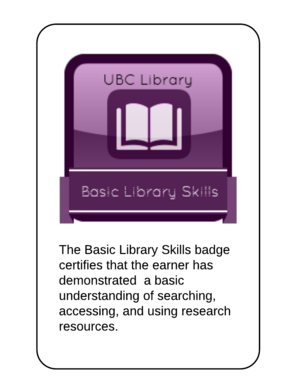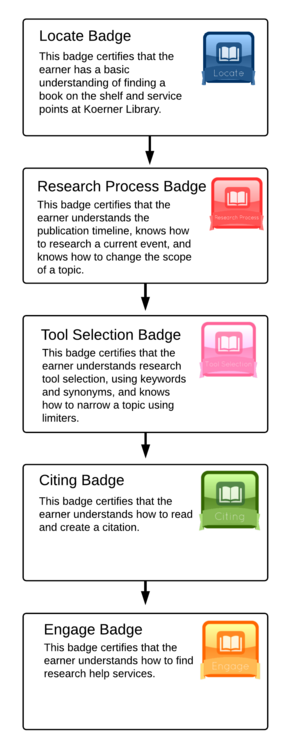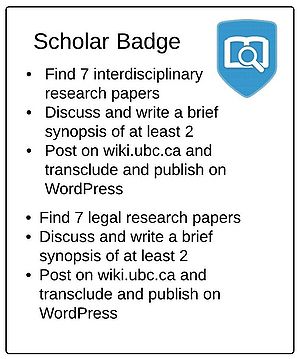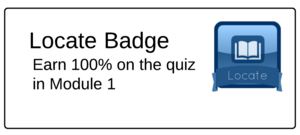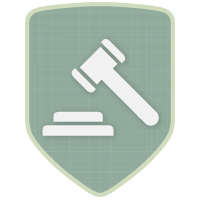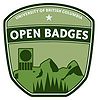Documentation:Open UBC/Education/Planning Open Badges for Courses
How to prepare your course for badging?
Implementing badging into your course/program can be as simple or as complex as your goals for learning. For example, your goal may be that learners engage in public discourse through comments on a course blog. In this case, the learning pathway is simple and straightforward - an assigned number of comments will earn you a badge. In another instance, your goal for learners may be to facilitate a design process - which involves a number of steps and competencies. Each step will need to be mapped out in terms of what learners will need to do in order to earn the badge. These steps may involve submissions, comments, quizzes or activities which will need to be verified. Once you map out one set of steps for earning a badge, you will want to have a conversation with a learning technologist to ensure that your requirements can be met.
Getting Started
When designing a badge pathway for your course, the following should be considered:
|
Touchpoints refer to your first considerations around criteria for the badge. Touchpoints must be considered in conjunction with badge issuing. The badge issuing determines how the badge will be awarded using the technology provided. There may be some constraints in how you offer your badge as not all badge issuing can be automated. For example, a badge can be issued when a blog post shows critical evaluation of an article but someone will need to review the post and issue the badge.
Leveled Badge Systems
Does the badge earner need previous skills or knowledge to earn a badge?
In addition to deciding on the types of badges you will issue, you need to consider whether to use badge levels. Badge levels is the structure or path in which badges are earned. Decisions about using badge levels depend on whether there is a hierarchy in the learning process that requires an earner to gain specific knowledge and/or skill before moving on. Badges levels can also be useful if a topic is complex enough that it needs to be broken down into sub-themes and competencies.
The following outlines the kinds of leveled badge systems that should be considered when designing a badge pathway.
Tiered Badges
Tiered badges place badges in an explicit hierarchy. The purpose of a tiered system may be the following:
- A student needs prior knowledge, skills, and/or behaviours before moving on to more complex material
- An instructor may want to track the progress through a topic by badge-specific milestones
A tiered system of badges can concentrate the efforts of badge earners on one topic, which deepens their knowledge as they move through content.

The Videographer badge requires increasing mastery of the subject before learning more complex skills.
Meta-level Badges
Meta-level badges represent several skills, behaviours, knowledge, and/or abilities that make up a higher level of understand around a larger topic. The type of learning here does not necessarily need to be hierarchical like with the tiered badge design. The purpose of meta-level badges is to identify the core competencies in a subtopic of a larger area of study. The purpose of a meta-level badge system may be the following:
- An instructor may want to scaffold a complicated topic by breaking it down into more manageable subtopics
- An instructor may want to target specific topics to signal mastery of a complex skill set

Web design skills require an understanding of basic design principles. These badge are meta-literacies that make a Design Principles badge for web designers.
Examples of Leveled Badge Systems
Badge Earning Criteria
What will learners need to do in order to get the badge?
The activity required for a student to earn a badges is important to consider seriously. For badges to hold real value and to carry authority, assessment and quality is critical. Badges can contain multiple levels of assessment, depending on the use case, community or intended audience. Some require distinct predefined assessment exercises and success criteria while others may be loosely defined and require earner reflection or peer recommendations.
Consider the perspective of both the earner and the issuer when developing badge criteria.
For badge earners:
- Is the badge sufficiently challenging for the skill or knowledge level of the badge earner?
- Alternately, is the badge too challenging for the badge earner?
- Will the badge help the badge earner get a job?
For badge issuers:
- Hard skills can require standard or more rigid rubrics to compare learner work against.
- Softer skills can be more fluid and require more open and social assessments like peer reviews or endorsements.
- For certification badges, intended for audiences like hiring managers, admission boards, more rigorous assessments can be required.
- For badges intended to simply build community or reward behaviors, simple assessments may be sufficient.
Examples of Badge Touchpoints
Getting Started
To plan the touchpoints of your badge learning pathway, consider how your badges connect with one another. That is, think about the order in which badges will be earned and answer the following questions.
|
|
Badge types are the general categories you will issue based on what sort of learning or engagement you are aiming for in your course or program. When planning your badge program design you'll need to decide on the types of badges you plan to issue based on the goals of both the course/program and of the badges themselves. Badge programs will often have a mixture of different types of badges on offer to better align with the goals and objectives of the whole program.
Badge Types
Example of Badge Type Selection
Getting Started
To plan the types of badges you will offer in your badge system, consider the following questions.
|
A badge which is aesthetically appealing may entice students to claim it, facilitating its purpose as a motivational tool. A beautiful badge is also more likely to be posted to social media, facilitating its purpose as a credential. For these reasons, is it important to design your badge thoughtfully. This guide will provide you with information on how to do so.
Getting Started
An Appropriate Aesthetic
When designing a badge, consider your audience. Adults may have different aesthetic tastes compared to youths, and badges from different disciplinary domains may warrant a different aesthetic. If you are not sure what aesthetic is appropriate for your badge, it might be an idea to look at websites, brochures, and logos associated with your badge concept.
A Meaningful Badge Design
Once you've got a sense of your aesthetic, consider the message you would like your badge to convey. A badge is more likely to have a powerful impact if the message and the visuals align. To identify your key message, it may be helpful to ask yourself:
- Do you want to make clear the achievement associated with earning the badge?
- Do you want to make clear the organization that issues the badge?

Once you've identified your key message, consider how you would like to convey it. Do you plan to use images or words?
In what follows, we describe how to deploy words and images for maximum effect.
Designing Text
Picking Fonts
Different fonts convey different messages. For example, Comic Sans may convey a light-hearted message, while Times New Roman may come across as very serious. One way to develop your sensitivity for appropriate fonts is to be observant of how fonts are used in the external world. In addition to selecting a font, you may also want to combine fonts. Often, fonts that look good together belong to the same typeface - that is, to a family of fonts sharing a common design but differing in weight, style, and width, but generally look alike.
For example, here is the Futura family of fonts:

It is also possible to select fonts from different typefaces for a pleasing effect. To do this, the following guides may be helpful
Designing Images
Picking Colours
If you plan to use images to convey your message, consider your colour choices. Generally, it is a good idea to restrict your badge to fewer than three colours. Simplicity is key!

In the process of designing your badge, it is often a good idea to experiment first with colours that are very different from one another - also known as complementary colours. To help you find complementary colours, Adobe's online program may prove useful - it automatically identifies the complementary colours for any given colour. Adobe's program also offers other methods of identifying pleasing colour combinations.
It also should be noted darker hues tend to look better on screens. As badges will typically be viewed online, darker hues are a good idea.
Picking Shapes
Consider using simple shapes when designing your badge. Simple shapes can powerfully convey your message, which leads to a stronger visual impact. By contrast, clutter can make it difficult to figure out what your badge represents.
Some people are tempted to reuse a brand logo or a department design in their badge icon. While such borrowing is a perfectly acceptable way of experimenting with different designs, it is best if your ultimate design is somewhat distinct from other designs found in your department. You'll want to send a message that your badge is not as easy to obtain as a logo of the department letterhead.
Badge Creator Tools
The following tools provide you options to design your badge image.
If you do not have the resources or the inclination to design your own badge, one alternative is to ask your audience of badge earners to submit their ideas for a badge icon. Not only can this approach generate very interesting designs, but it may also draw people into the badging program.
